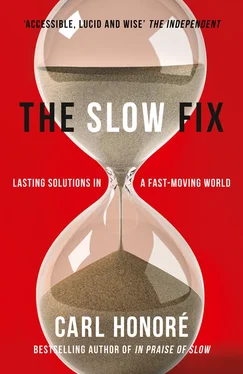Nowadays, though, it is no longer just politicians and business chiefs that believe they can wave a magic wand. We’re all at it in this age of bullshit, bluster and blarney. Look at the parade of tone-deaf wannabes vowing to be the next Michael Jackson or Lady Gaga on The X Factor . With so much pressure to stand out, we embellish our CVs, post flattering photos on Facebook and holler for attention on blogs and Twitter. A recent study found that 86 percent of 11-year-olds use social media to build their ‘personal brand’ online. Some of this chest-thumping may win friends and influence people, but it can also drive us into the arms of the quick fix. Why? Because we end up lacking the humility to admit that we do not have all the answers, that we need time and a helping hand.
The self-help industry must take some of the blame for this. After years of reading and writing about personal development, Tom Butler-Bowdon fell out of love with his own field. Too many motivational gurus, he decided, hoodwink the public with short cuts and quick fixes that do not really work. As a riposte, he published Never Too Late to Be Great , which shows how the best solutions in every field, from the arts to business to science, usually have a long gestation period. ‘By glossing over the fact that it takes time to produce anything of quality, the self-help industry has bred a generation of people that expect to fix everything tomorrow,’ he says.
The media add fuel to that fire. When anything goes wrong – in politics, business, a celebrity relationship – journalists pounce, dissecting the crisis with glee and demanding an instant remedy. After the golfer Tiger Woods was outed as a serial philanderer, he vanished from the public eye for three months before finally breaking his silence to issue a mea culpa and announce he was in therapy for sex addiction. How did the media react to being made to wait that long? With fury and indignation. The worst sin for a public figure on the ropes is to fail to serve up an instant exit strategy.
That impatience fuels a tendency to overhype fixes that later turn out to be complete turkeys. An engineer by training, Marco Petruzzi worked as a globetrotting management consultant for 15 years before abandoning the corporate world to build better schools for the poor in the United States. We will meet him again later in the book, but for now consider his attack on our culture of hot air. ‘In the past, hard-working entrepreneurs developed amazing stuff over time, and they did it, they didn’t just talk about it, they did it,’ he says. ‘We live in a world now where talk is cheap and bold ideas can create massive wealth without ever having to deliver. There are multi-billionaires out there who never did anything but capture the investment cycle and the spin cycle at the right moment, which just reinforces a culture where people don’t want to put in the time and effort to come up with real and lasting solutions to problems. Because if they play their cards right, and don’t worry about the future, they can get instant financial returns.’
From most angles, then, the quick fix looks unassailable. Everything from the wiring of our brains to the ways of the world seems to favour band-aid solutions. Yet all is not lost. There is hope. Wherever you go in the world today, and in every walk of life, more people are turning away from the quick fix to find better ways to solve problems. Some are toiling below the radar, others are making headlines, but all share one thing in common: a hunger to forge solutions that actually work.
The good news is the world is full of Slow Fixes. You just have to take the time to find and learn from them.
CHAPTER TWO
CONFESS: The Magic of Mistakes and the Mea Culpa
Success does not consist in never making mistakes but in never making the same one a second time.
George Bernard Shaw
On a crisp night in early September, four Typhoon fighter jets roared across the sky above the freezing waters of the North Sea. Locked in a two-on-two dogfight, they swooped, banked and sliced through the darkness at up to 500 miles per hour, searching for a kill-shot. It was a training exercise, but to the pilots it all seemed very real. Strapped into his cockpit, with 24,000 pounds of killing machine throbbing at his fingertips, Wing Commander Dicky Patounas was feeling the adrenaline. It was his first night-time tactical sortie in one of the most powerful fighter jets ever built.
‘We’re in lights off because we’re doing this for real, which we don’t do very often, so it’s pitch black and I’m on goggles and instruments only,’ Patounas recalls. ‘I’m working the radar, putting it in the right mode by shortening the range, changing the elevation, all basic stuff. But the plane was new to me, so I’m maxed out.’ And then something went wrong.
A few months later Patounas relives that night back on the ground. His air base, RAF Coningsby, is in Lincolnshire, an eastern county of England whose flat, featureless terrain is prized more by aviators than by tourists. Dressed in a green flight suit festooned with zippers, Patounas looks like a Top Gun pilot from central casting – square jaw, broad shoulders, ramrod posture and cropped hair. He whips out pen and paper to illustrate what happened next on that September night, speaking in the clipped tones of the British military.
Patounas was flying behind the two ‘enemy’ Typhoons when he decided to execute a manoeuvre known as the overshoot to a Phase 3 Visual Identification (VID). He would pull out to the left and then slingshot back onto his original course, popping up right behind the trailing enemy plane. But something unforeseen happened. Instead of holding their course, the two rival jets up ahead banked left to avoid a helicopter 20 miles away. Both pilots announced the change on the radio but Patounas failed to hear it because he was too distracted executing his manoeuvre. ‘It’s all quite technical,’ he says. ‘You’ve got to do 60 degrees angle of bank through 60 degrees and then roll out for 20 seconds, then put your scanner down by 4 degrees, then change your radar to 10-mile scale, and after 20 seconds you come right using 45 degrees angle of bank, you go through 120 degrees, you roll out and pick up the guy on your radar and he should be at about 4 miles. So I’m working all this out and I miss the radio call stating the new heading.’
When Patounas rolled back out of the manoeuvre, he spotted an enemy Typhoon in front of him just as expected. He was pumped. ‘This aircraft now appears under my cross where I put it for the guy to appear, so I think I’ve done the perfect overshoot,’ he says. ‘I’ve set my radar up, pitched back in and the guy I’m looking for is under my cross in the pitch black. And I go, “I’m a genius, I’m good at this shit.” I was literally thinking I’ve never flown one so perfectly.’
He shakes his head and laughs wryly at his own hubris: it turned out the wrong Typhoon was in his crosshairs. Instead of ending up behind the trailing jet, Patounas was following in the slipstream of the frontrunner – and he had no idea. ‘It was my mistake: I basically lost awareness of two of the aircraft,’ he says. ‘I knew they were there but I didn’t ensure I could see two tracks. What I should have done was bump the range scale up and have a look for the other guy, but I didn’t because I said to myself, “This is perfect.”’
The result was that Patounas passed within 3,000 feet of the rear Typhoon. ‘It wasn’t that close but the key is I had no awareness, because I didn’t even know he was there,’ he says. ‘It could have been three feet, or I could have flown right into him.’ Patouanas falls quiet for a moment, as if picturing the worst-case scenario. On that September night his wingman watched the whole fiasco unfold, knew there was no real danger of a collision and allowed the exercise to continue, but a similar mistake in real combat could have been catastrophic – and Patounas knew it.
Читать дальше












